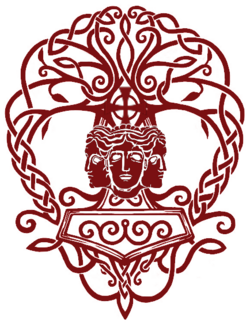Templar Order
| Templar Order | |
|---|---|
 | |
| Active | 16 CE-Present |
| Country | |
| Size | Unknown |
| Garrison/HQ | Ædísstad, Vrinnevid, Rena |
| Colors | White, black, red |
| Commanders | |
| Commandant | Eirik Vaernes |
| Vice Commandant | Léon Caillat |
The Templar Order is an Acrean religious military order which serves as an armed force and honour guard. The Templar Order was formed dually as both a religious organisation and a military organisation, charged as the protectors of Acrea's most important religious sites at the Vǫlís in Uppsala and Ædís in Rena, and as a bodyguard for the royalty. The order was first formally established by imperial decree in 16 CE, though its traditions date back several centuries further. By the 2nd Century CE, the Templars also sometimes served as an elite fighting force on campaign. The word "Templar" is derived from the Elder Nordic, templeriddari, referring to their status as warriors who protected major places of worship.
With their status in Acrean society, Templars have historically been known not just for their battlefield prowess but for their secretive nature and political intrigues. Historically, Templars often made up a number of the highest military advisory positions in royal cabinets, something which only began to change following the Ivorian Reforms of the 14th century. Their status as royal bodyguards and in numerous historical cases, royal confidantes, has left the Templars inextricably linked to Acrean royalty to the present day. In their modern security role, the Templars function as their own self-sufficient security service, and alongside the Templar guardsmen also maintain their own tactical units and intelligence branch. They also maintain administrative and academic branches, the latter of which is well known for its extensive archives and libraries which may be accessed by scholars.
History
Since the early Empire, the Templars formed the core of Acrea's warrior society. They were considered to be an iconic embodiment of the virtues of ancient Acrean culture such as discipline, fitness, and strength in mind and body. Although membership in the order was at first dependent on a warrior's acceptance following trials, in 100 CE this had been supplemented by the adoption of the aleiðval from the Arcani. Referring both to the institution and the regime practiced there, the aleiðval was a strict regime of training and education which parents could enter their sons (and in some recorded cases, daughters) into at the age of eight. The aleiðval put pupils through a rigorous curriculum that lasted until the age of 20. Although much of the education at the aleiðval focused on fostering martial skills, pupils were also instructed in literature, poetry, academics, and politics. Accompanying this education was sports and wargames, alongside a strict fitness regime. Pupils were considered to have passed the aleiðval once they reached the age of 20, having satisfactorily reached all of the milestones and expectations set by their instructors, at which point they were inducted as full warriors. Failing to meet all of these expectations did not necessarily mean that a pupil was cast out from the aleiðval, depending on the aspects of their education that they failed. Although failing the academic portions of their education normally meant expulsion, those who did not prove as physically strong but performed strongly in academics would be retained to serve in the Order's administration. The creation of the aleiðval meant that by at least 200 BCE, being a Templar was often a generational matter.